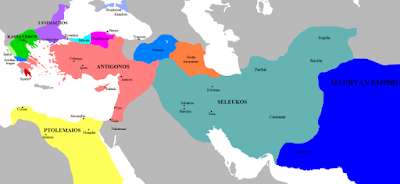Does the Ancient Middle East Have Lessons for Today
Here’s a terrific essay about the similarities between the ancient and modern states of the Middle East. It might be a great assignment for students as a review of what happened in Asia after Alexander the Great died or for students studying the Middle East today.
In an essay for the History News Network, Philip Jenkins, professor of history at the Institute for Studies of Religion at Baylor University, argues that the ancient history of the Middle East is not that different from the chaos and terror that characterizes the region today.
Jenkins looks at the Seleucid empire in 200CE with its capital city just twenty miles from Bagdad. He notes that at its height, it was the most populous city in the world. In India, Seleucid power imported war-elephants, perhaps the most cutting-edge military weapon of the day. And the empire left a rich cultural heritage in science, a result of the Greek influence of the Seleucids.
The Romans defeated the Seleucids in 190BCE. The empire split up and outside powers worked hard to keep them divided. Their division allowed Greek conquerors to unite the Mediterranean world with central Asia and control the profitable textile and spice trade. “Then as now,” Jenkins argues, “greed for priceless raw materials drove political aggression and interference.”
Jenkins goes on to show how Persia filled the vacuum produced by the break-up of the Seleucid empire, just as it seems to be doing today.
Jenkins is a great historian and his new book, Crucible of Faith: The Ancient Revolution That Made Our Modern Religious World, looks very interesting.
In an essay for the History News Network, Philip Jenkins, professor of history at the Institute for Studies of Religion at Baylor University, argues that the ancient history of the Middle East is not that different from the chaos and terror that characterizes the region today.
Jenkins looks at the Seleucid empire in 200CE with its capital city just twenty miles from Bagdad. He notes that at its height, it was the most populous city in the world. In India, Seleucid power imported war-elephants, perhaps the most cutting-edge military weapon of the day. And the empire left a rich cultural heritage in science, a result of the Greek influence of the Seleucids.
The Romans defeated the Seleucids in 190BCE. The empire split up and outside powers worked hard to keep them divided. Their division allowed Greek conquerors to unite the Mediterranean world with central Asia and control the profitable textile and spice trade. “Then as now,” Jenkins argues, “greed for priceless raw materials drove political aggression and interference.”
Jenkins goes on to show how Persia filled the vacuum produced by the break-up of the Seleucid empire, just as it seems to be doing today.
Jenkins is a great historian and his new book, Crucible of Faith: The Ancient Revolution That Made Our Modern Religious World, looks very interesting.

Comments
Post a Comment